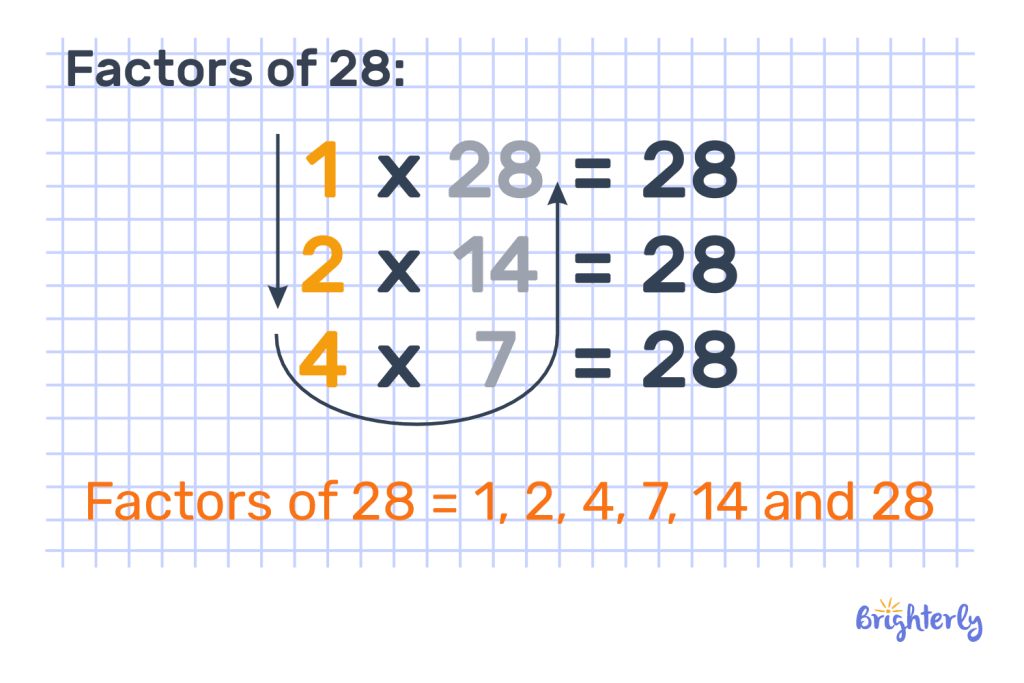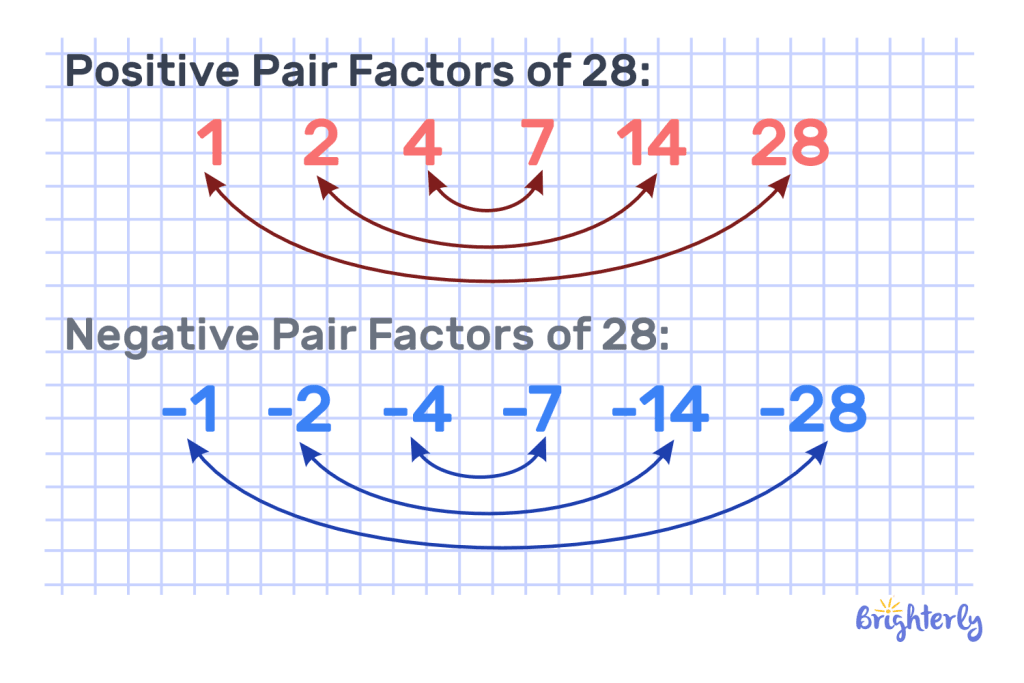Factors of 28 – Definition With Examples
Updated on November 29, 2025
Have you ever wondered how numbers work? Every number has a small secret of its own, and 28 is no exception! Factors are certain numbers that fit inside it perfectly. At Brighterly, our goal is to demonstrate what makes 28, how it can be divided into smaller parts, why certain numbers are unique, and how everything works together. As you explore factors, multiples, and prime numbers, you will learn that math is more than just counting.
What are the factors of 28?
Factors of 28 are any numbers that divide 28 without leaving a remainder. To put it another way, multiplying these two numbers results in 28. Despite 28’s many fascinating numbers, every number has at least two factors: 1 and itself. Here we list all the factors of 28:
- 1
- 2
- 4
- 7
- 14
- 28
Examples of factors of 28
1, 2, 4, 7, 14, and 28 are all factors of 28. There is no remainder when 28 is divided by these numbers. For instance, look at the image:

These factor pairs demonstrate how 28 can be divided into smaller components. You can use this when:
- 28 apples should be divided into baskets.
- Creating a game with 28 steps.
- Putting 28 books on a shelf.
Properties of factors of 28
There are several methods for multiplying back to 28 by combining its factors. We can use these factor pairs to share, organize, and solve basic math problems, like dividing 28 evenly.
| Factor 1 | Factor 2 | Product |
| 1 | 28 | 28 |
| 2 | 14 | 28 |
| 4 | 7 | 28 |
Unique properties of factors of 28
If we add 1 + 2 + 4 + 7 + 14, we get the number 28. There seems to be a perfect fit between the numbers. It shows how numbers can work together neatly and logically when you see this pattern.
Difference between factors of 28 and multiples of 28
Some numbers show how to divide a number into smaller parts, while others show how to increase it — these are the factors and multiples, accordingly. The numbers 1, 2, 4, 7, 14, and 28 are considered factors because they divide 28 perfectly. These are your answers if you wonder, “What numbers go into 28?”
Multiples, on the other hand, are numbers you receive when you add 28: 28, 56, 84, 112, and so on. By using them, you can see how the number 28 can grow infinitely.
Factor pairs of 28
In factor pairs, two numbers multiply to create 28. A few examples are 1×28, 2×14, and 4×7. Take a look at how these factor pairs work:

Finding factors of 28
To find a factor of 28, check which numbers divide 28 perfectly, leaving nothing behind — these are the answers to, “What can 28 be divided by?” The numbers that do allow this operation are: 1, 2, 4, 7, 14, and 28.
Steps in determining factors of 28
You can find the factors of 28 by following these steps:
- Start with 1 – 28 ÷ 1 = 28. Any number is always divided by itself and 1, so both 1 and 28 are factors in this case.
- Check 2 – 28 ÷ 2 = 14. So, 2 and 14 are a pair factor of 28.
- Check 3 – 28 ÷ 3 leaves a remainder, so skip it.
- Check 4 – 28 ÷ 4 = 7. So, 4 and 7 are another factor of 28 in pairs.
- Stop at 28 – Once you reach 28 itself, you have found all factors.
With this list at hand, you can also explore the prime factorization of 28, which is 2 × 2 × 7 (or 2² × 7). Using the factors of 28 in pairs, you can easily see how each number works together to make 28.
Practice problems on finding factors of 28
- Make a list of all 28 factors and arrange them from smallest to largest.
- Draw the factors of 28 in pairs.
- Distribute 28 candies among seven friends. How many candies does each friend receive, as determined by which factor of 28?
- To determine whether 28 can be created by multiplying smaller numbers, use the prime factorization of 28.
Conclusion
You can learn a lot about numbers by exploring all the factors of 28. By working with factor pairs, kids also learn how to divide numbers into equal groups. In everyday life, this applies to dividing things evenly among friends, arranging items to fit neatly, or figuring out how many parts make up a large product. You begin to notice how frequently these simple concepts appear in your everyday life as you break down 28 in different ways.
Frequently asked questions on factors of 28
What are factors of 28?
Factors of 28 are numbers that divide 28 exactly. You can split 28 by them without anything left over.
What are all the factors of 28?
All the factors of 28 are 1, 2, 4, 7, 14, and 28.
What is the prime factorization of 28?
The prime factorization of 28 shows which prime numbers make 28. For 28, it’s 2 × 2 × 7, or 2² × 7, because 2 and 7 are prime numbers.
Is 28 a prime number?
No, 28 isn’t a prime number. There are more than two factors: 1, 2, 4, 7, 14, and 28. This implies that 28 can be broken up into smaller components.






